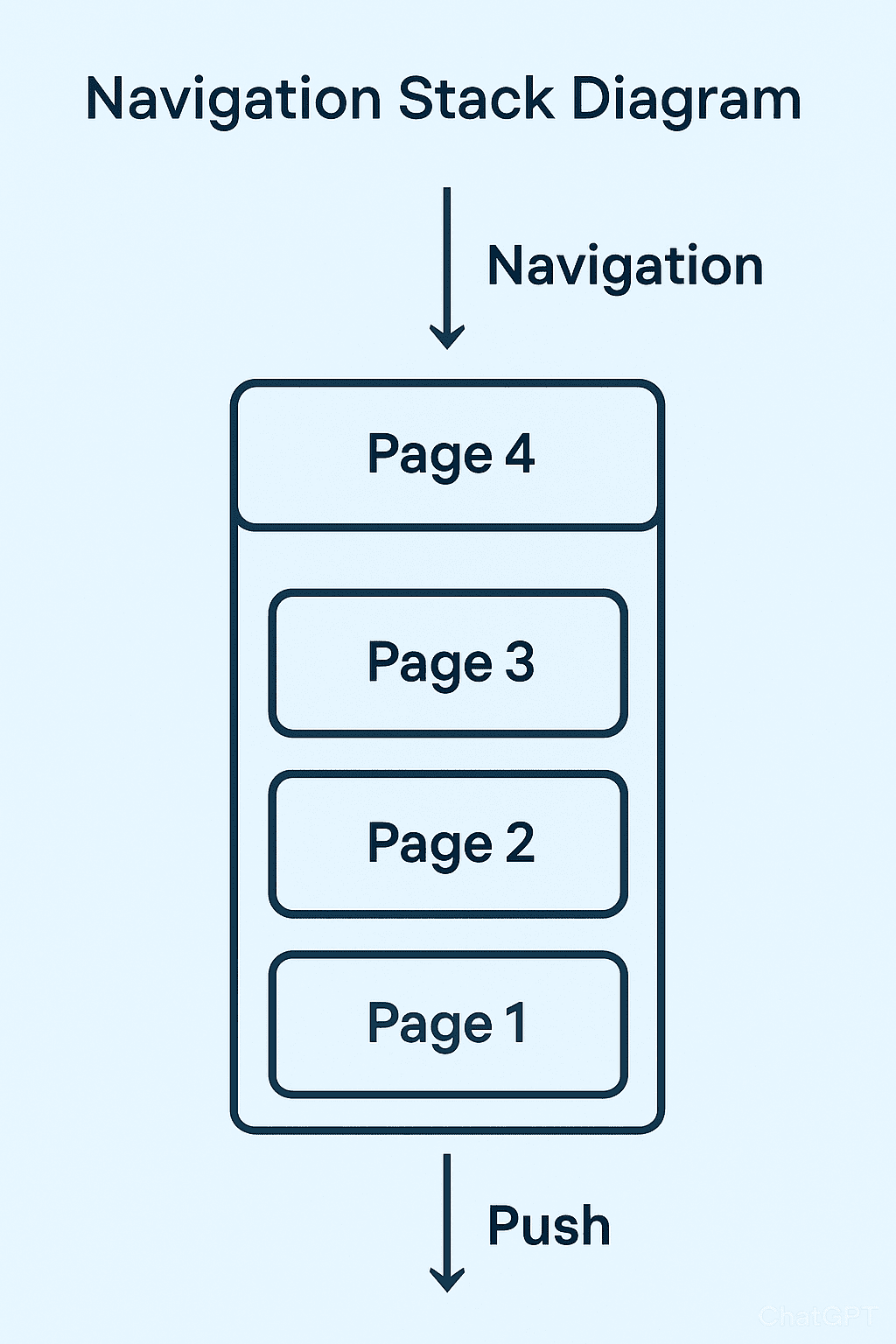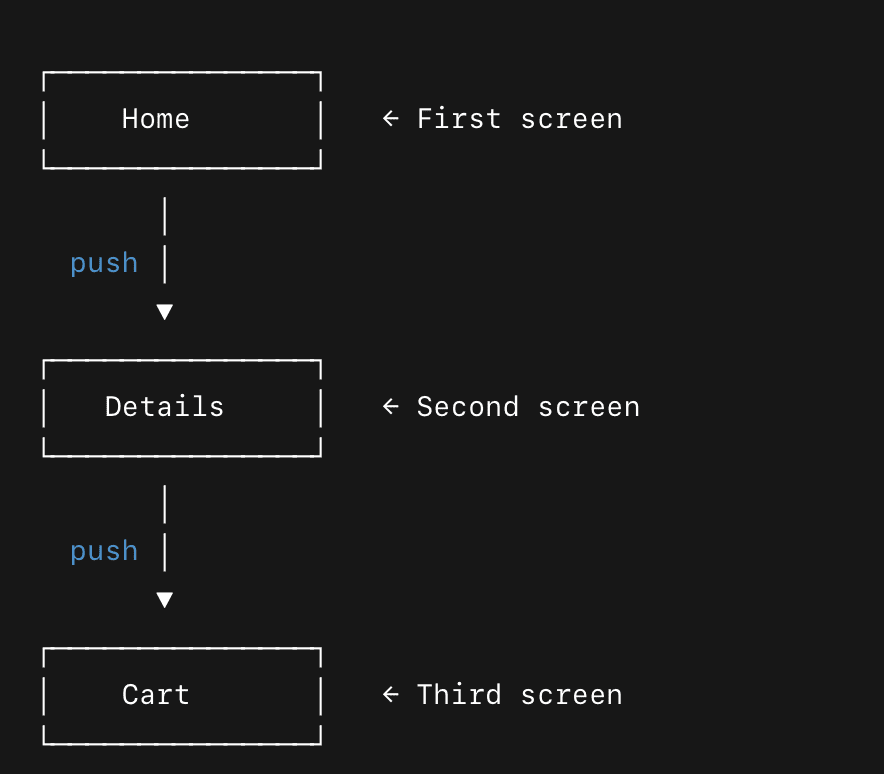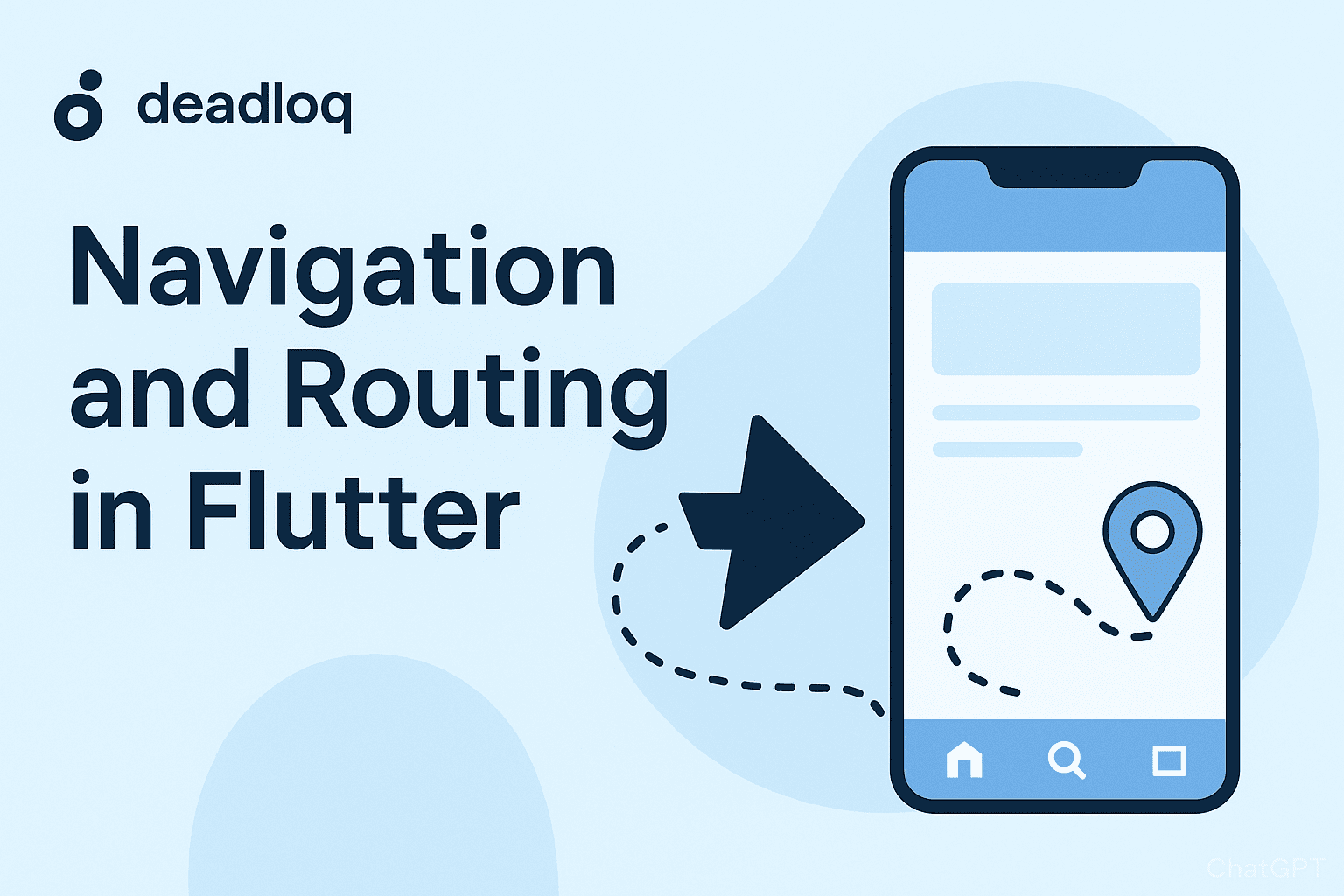Introduction
In any mobile app, moving between different screens is essential. For example, tapping on a product in an e-commerce app might take you to its details page. This process of moving between screens is called navigation, while the definition and management of those screens are referred to as routing.
In Flutter, navigation is powerful and flexible. Developers can use Navigator 1.0 (imperative navigation), Named Routes (centralized routing), or Navigator 2.0 (declarative navigation). Each approach has its own strengths and use cases.
Throughout this guide, we’ll cover:
- Navigator 1.0 (basic push/pop navigation)
- Named Routes (cleaner, centralized navigation)
- Navigator 2.0 (modern, declarative navigation for complex apps)
- Passing data between screens
- Error handling and unknown routes
- Popular routing packages
What is Navigation and Routing in Flutter?
Navigation: The process of moving between different screens (widgets).
Routing: The mechanism of defining, managing, and handling screen transitions.
Quick Decision Guide
- Starting a simple app? → Use Navigator 1.0
- Building a medium-sized mobile app? → Use Named Routes
- Need web support or deep linking? → Use go_router
- Working on a complex enterprise app? → Consider Navigator 2.0 or auto_route
Understanding the Navigation Stack
Flutter uses a stack-based navigation model. The current screen sits on top of the stack, and when a new screen is pushed, it sits above the previous one. When popped, the screen is removed from the stack. This is similar to how web browsers handle page history.


For a deeper understanding of Flutter’s widget system, check out the official Flutter documentation.
Navigator 1.0 (Imperative Navigation)
Navigator 1.0 is the classic way of handling navigation in Flutter. It’s straightforward and works well for simple applications.

Basic Push and Pop Navigation
// Navigate to another screen Navigator.push( context, MaterialPageRoute(builder: (context) => SecondScreen()), ); // Go back to previous screen Navigator.pop(context);
Passing Data Forward
Additionally, you can pass data when navigating to a new screen:
Navigator.push(
context,
MaterialPageRoute(
builder: (context) => ProductDetailScreen(productId: '123'),
),
);
Receiving Data Back
Furthermore, you can receive data when returning from a screen:
// Navigate and wait for result
final result = await Navigator.push(
context,
MaterialPageRoute(builder: (context) => EditScreen()),
);
if (result != null) {
// Handle the returned data
print('Received: $result');
}
// In the EditScreen, return data when user presses save
ElevatedButton(
onPressed: () {
Navigator.pop(context, 'Updated data');
},
child: Text('Save'),
)
Navigator 1.0: Pros and Cons
Pros:
- Simple and quick to implement
- Great for small apps
- Direct and intuitive
- Minimal learning curve
Cons:
- Hard to manage in large apps
- Routes are scattered across multiple files
- No URL support for web applications
- Difficult to implement deep linking
Named Routes in Flutter
Moving from basic navigation, Named routes provide a more organized approach by centralizing navigation logic. Instead of defining routes inline, you define them in one place and use route names across the app.
Setting Up Named Routes
void main() {
runApp(MaterialApp(
initialRoute: '/',
routes: {
'/': (context) => HomeScreen(),
'/second': (context) => SecondScreen(),
'/profile': (context) => ProfileScreen(),
'/settings': (context) => SettingsScreen(),
},
// Handle unknown routes
onUnknownRoute: (settings) => MaterialPageRoute(
builder: (context) => NotFoundScreen(),
),
));
}
Navigating Between Named Routes
Once you’ve defined your routes, navigation becomes cleaner:
// Navigate to named route
Navigator.pushNamed(context, '/second');
// Navigate with arguments
Navigator.pushNamed(
context,
'/profile',
arguments: {'userId': '123'},
);
Handling Arguments in Named Routes
Moreover, you can receive and process arguments in your destination screens:
class ProfileScreen extends StatelessWidget {
@override
Widget build(BuildContext context) {
final args = ModalRoute.of(context)?.settings.arguments as Map<String, dynamic>?;
final userId = args?['userId'] ?? 'Unknown';
return Scaffold(
appBar: AppBar(title: Text('Profile: $userId')),
body: Center(child: Text('User ID: $userId')),
);
}
}
Best Practice: Route Constants
To improve maintainability, create a constants file for your routes:
class Routes {
static const String home = '/';
static const String profile = '/profile';
static const String settings = '/settings';
static const String productDetail = '/product-detail';
}
// Usage
Navigator.pushNamed(context, Routes.profile);
Named Routes: Pros and Cons
Pros:
- Cleaner and more organized
- Easier to manage when app grows
- Centralized route definitions
- Better for testing
Cons:
- Still imperative approach
- Limited flexibility for advanced cases
- Arguments are not type-safe
- No built-in deep linking support
Navigator 2.0 (Declarative Navigation)
As Flutter apps became larger and more complex, Navigator 1.0 and Named Routes showed limitations. Consequently, Navigator 2.0 was introduced to address these challenges, especially for:
- Web apps (URL-based navigation)
- Deep linking (opening specific screens from external links)
- Nested navigation (apps with multiple navigation stacks)
- Browser back button support
Quick Note: If Navigator 2.0 feels too complex, jump to the routing packages section — they simplify everything while giving you the same benefits!
Navigator 2.0 Core Components
Before diving into code, let’s understand the three main components:
Step 1: Understanding RoutePath
First, you need to define your app’s route structure:
class RoutePath {
final String location;
final bool isUnknown;
RoutePath.home() : location = '/', isUnknown = false;
RoutePath.second() : location = '/second', isUnknown = false;
RoutePath.unknown() : location = '/404', isUnknown = true;
bool get isHome => location == '/';
bool get isSecond => location == '/second';
}
Step 2: Creating the Route Parser
Next, implement the RouteInformationParser to handle URL parsing:
class MyRouteInformationParser extends RouteInformationParser<RoutePath> {
@override
Future<RoutePath> parseRouteInformation(RouteInformation routeInformation) async {
final uri = Uri.parse(routeInformation.location ?? '/');
if (uri.pathSegments.isEmpty) {
return RoutePath.home();
}
if (uri.pathSegments.length == 1) {
switch (uri.pathSegments[0]) {
case 'second':
return RoutePath.second();
default:
return RoutePath.unknown();
}
}
return RoutePath.unknown();
}
@override
RouteInformation? restoreRouteInformation(RoutePath path) {
return RouteInformation(location: path.location);
}
}
Step 3: Implementing the Router Delegate
Then, create the RouterDelegate to manage your app’s navigation state:
class MyRouterDelegate extends RouterDelegate<RoutePath>
with ChangeNotifier, PopNavigatorRouterDelegateMixin<RoutePath> {
final GlobalKey<NavigatorState> navigatorKey = GlobalKey<NavigatorState>();
RoutePath _currentPath = RoutePath.home();
@override
Widget build(BuildContext context) {
return Navigator(
key: navigatorKey,
pages: [
MaterialPage(
key: ValueKey('home'),
child: HomeScreen(onNavigateToSecond: _handleNavigateToSecond),
),
if (_currentPath.isSecond)
MaterialPage(
key: ValueKey('second'),
child: SecondScreen(),
),
if (_currentPath.isUnknown)
MaterialPage(
key: ValueKey('unknown'),
child: NotFoundScreen(),
),
],
onPopPage: (route, result) {
if (!route.didPop(result)) return false;
if (_currentPath.isSecond) {
_currentPath = RoutePath.home();
notifyListeners();
}
return true;
},
);
}
void _handleNavigateToSecond() {
_currentPath = RoutePath.second();
notifyListeners();
}
@override
Future<void> setNewRoutePath(RoutePath path) async {
_currentPath = path;
}
}
Step 4: Wiring Everything Together
Finally, connect all components in your main app:
void main() {
runApp(MyApp());
}
class MyApp extends StatelessWidget {
final MyRouterDelegate _routerDelegate = MyRouterDelegate();
final MyRouteInformationParser _routeInformationParser = MyRouteInformationParser();
@override
Widget build(BuildContext context) {
return MaterialApp.router(
routerDelegate: _routerDelegate,
routeInformationParser: _routeInformationParser,
);
}
}
While verbose, this approach allows full control over URLs, deep links, and nested navigation.
Navigator 2.0: Pros and Cons
Pros:
- Declarative and scalable
- Supports web URLs and deep linking
- Browser back button support
- Flexible for complex apps
- Better state management
- SEO-friendly for web apps
Cons:
- Verbose and more complex to implement
- Steeper learning curve
- More boilerplate code
- Overkill for simple apps
Handling Unknown Routes and Errors
Regardless of which navigation approach you choose, handling unknown routes is crucial for a good user experience.
Error Handling in Navigator 1.0 and Named Routes
MaterialApp(
routes: {
'/': (context) => HomeScreen(),
'/profile': (context) => ProfileScreen(),
},
onUnknownRoute: (settings) {
return MaterialPageRoute(
builder: (context) => NotFoundScreen(),
);
},
)
Error Handling in Navigator 2.0
In contrast, Navigator 2.0 handles unknown routes in the RouteInformationParser:
@override
Future<RoutePath> parseRouteInformation(RouteInformation routeInformation) async {
final uri = Uri.parse(routeInformation.location ?? '/');
// Handle known routes
if (uri.pathSegments.isEmpty) return RoutePath.home();
if (uri.pathSegments[0] == 'profile') return RoutePath.profile();
// Return unknown route for unmatched paths
return RoutePath.unknown();
}
Creating a User-Friendly 404 Screen
Additionally, create a dedicated NotFoundScreen for better UX:
class NotFoundScreen extends StatelessWidget {
@override
Widget build(BuildContext context) {
return Scaffold(
appBar: AppBar(title: Text('Page Not Found')),
body: Center(
child: Column(
mainAxisAlignment: MainAxisAlignment.center,
children: [
Icon(Icons.error_outline, size: 64, color: Colors.grey),
SizedBox(height: 16),
Text('The page you are looking for does not exist.'),
SizedBox(height: 16),
ElevatedButton(
onPressed: () => Navigator.pushReplacementNamed(context, '/'),
child: Text('Go Home'),
),
],
),
),
);
}
}
Comparison: Choosing the Right Approach
| Feature | Navigator 1.0 | Named Routes | Navigator 2.0 | Routing Packages |
|---|---|---|---|---|
| Best for | Small apps | Medium apps | Large/complex apps | Medium to large apps |
| Style | Imperative | Imperative (centralized) | Declarative | Declarative (simplified) |
| Deep Linking | No | NO | YES | YES |
| Web Support | Limited | Limited | YES | YES |
| URL Support | NO | NO | YES | YES |
| Type Safety | NO | NO | Manual | YES (some packages) |
| Learning Curve | Low | Low | High | Medium |
| Boilerplate | Low | Low | High | Low to Medium |
| Maintenance | Hard | Medium | Medium | Easy |
Best Practices
Route Organization
First and foremost, keep route definitions organized and maintainable:
// routes.dart
class AppRoutes {
static const String home = '/';
static const String profile = '/profile';
static const String settings = '/settings';
static const String productDetail = '/product/:id';
}
Performance Considerations
Moreover, consider these performance tips:
- Use
Navigator.pushReplacement()instead ofNavigator.push()when users shouldn’t return - Consider lazy loading for heavy screens
- Use
Navigator.pushAndRemoveUntil()for authentication flows
Testing Navigation
Additionally, always test your navigation logic:
testWidgets('should navigate to profile screen', (tester) async {
await tester.pumpWidget(MyApp());
await tester.tap(find.byKey(Key('profile_button')));
await tester.pumpAndSettle();
expect(find.byType(ProfileScreen), findsOneWidget);
});
Frequently Asked Questions
Q: What’s the difference between push and pushReplacement?
A: Navigator.push() adds a new screen on top of the current one, allowing users to go back. In contrast, Navigator.pushReplacement() replaces the current screen, removing it from the stack so users can’t return to it. Therefore, use pushReplacement() for login flows or when you don’t want users to navigate back.
// User can go back to previous screen Navigator.push(context, MaterialPageRoute(builder: (context) => NewScreen())); // User cannot go back to previous screen Navigator.pushReplacement(context, MaterialPageRoute(builder: (context) => NewScreen()));
Q: How do I pass data between screens in Navigator 1.0?
A: You can pass data through the constructor when navigating to a new screen, and subsequently return data using Navigator.pop():
// Pass data to new screen
Navigator.push(
context,
MaterialPageRoute(
builder: (context) => DetailScreen(productId: 'ABC123'),
),
);
// Return data from screen
Navigator.pop(context, {'result': 'success', 'data': updatedData});
Q: Should I use Navigator 2.0 or a routing package?
A: For most projects, use a routing package like go_router. Raw Navigator 2.0 requires significant boilerplate code. However, routing packages provide Navigator 2.0’s benefits (deep linking, web support) with much simpler implementation.
Q: How do I handle the Android back button?
A: Use WillPopScope (deprecated) or PopScope (Flutter 3.12+) to intercept back button presses. Furthermore, you can show custom dialogs or perform specific actions:
PopScope(
canPop: false, // Prevents default back behavior
onPopInvoked: (didPop) {
if (!didPop) {
// Show confirmation dialog or perform custom action
showDialog(
context: context,
builder: (context) => AlertDialog(
title: Text('Exit App?'),
content: Text('Are you sure you want to exit?'),
actions: [
TextButton(
onPressed: () => Navigator.of(context).pop(),
child: Text('Cancel'),
),
TextButton(
onPressed: () => SystemNavigator.pop(),
child: Text('Exit'),
),
],
),
);
}
},
child: YourScreen(),
)
Q: How do I implement deep linking in Flutter?
A: Deep linking is easiest with routing packages. With go_router, for instance:
final router = GoRouter(
routes: [
GoRoute(
path: '/',
builder: (context, state) => HomeScreen(),
),
GoRoute(
path: '/product/:id',
builder: (context, state) => ProductScreen(
productId: state.pathParameters['id']!,
),
),
],
);
// This URL will automatically navigate to ProductScreen
// myapp://product/123 or https://myapp.com/product/123
Q: How do I navigate without BuildContext?
A: Use a global navigator key. However, use this approach sparingly as it can make testing more difficult:
// Define global key
final GlobalKey<NavigatorState> navigatorKey = GlobalKey<NavigatorState>();
// In MaterialApp
MaterialApp(
navigatorKey: navigatorKey,
// ... other properties
)
// Navigate from anywhere
navigatorKey.currentState?.pushNamed('/login');
Q: What’s the best way to handle nested navigation?
A: Use packages like go_router with shell routes, or alternatively implement custom nested navigators:
// With go_router
final router = GoRouter(
routes: [
ShellRoute(
builder: (context, state, child) => BottomNavScaffold(child: child),
routes: [
GoRoute(path: '/home', builder: (context, state) => HomeScreen()),
GoRoute(path: '/profile', builder: (context, state) => ProfileScreen()),
],
),
],
);
Q: How do I prevent users from going back to the login screen after authentication?
A: Use Navigator.pushAndRemoveUntil() to clear the navigation stack:
Navigator.pushAndRemoveUntil( context, MaterialPageRoute(builder: (context) => HomeScreen()), (route) => false, // Remove all previous routes );
Q: Can I animate transitions between screens?
A: Yes, create custom PageRouteBuilder or use packages. Additionally, you can create smooth, custom animations:
Navigator.push(
context,
PageRouteBuilder(
pageBuilder: (context, animation, secondaryAnimation) => NewScreen(),
transitionsBuilder: (context, animation, secondaryAnimation, child) {
return SlideTransition(
position: animation.drive(
Tween(begin: Offset(1.0, 0.0), end: Offset.zero),
),
child: child,
);
},
),
);
Q: How do I test navigation in Flutter?
A: Use flutter_test and mock navigation. Furthermore, test both the navigation logic and the resulting UI state:
testWidgets('should navigate to detail screen', (tester) async {
await tester.pumpWidget(MyApp());
await tester.tap(find.byKey(Key('detail_button')));
await tester.pumpAndSettle();
expect(find.byType(DetailScreen), findsOneWidget);
});
Conclusion
Navigation and routing are fundamental aspects of building interactive Flutter applications. The choice between different approaches depends on your app’s complexity and requirements:
- Navigator 1.0 → Perfect for small, simple apps with basic navigation needs
- Named Routes → Good for medium-sized apps that need organized, centralized routing
- Navigator 2.0 → Powerful for large apps requiring deep linking, web support, and complex navigation patterns
- Routing Packages → Best balance of power and simplicity for most modern Flutter applications
For new projects, consider starting with go_router as it provides the benefits of Navigator 2.0 with much less complexity. For existing projects, evaluate your current needs and migration effort before switching approaches.
Remember that good navigation enhances user experience, while poor navigation can make even the best app feel clunky. Choose the approach that best fits your project’s needs and team’s expertise.
For more information on Flutter navigation, visit the official Flutter navigation documentation and explore the Flutter cookbook for practical examples.
For more content Visit Deadloq. Thank You!!!
